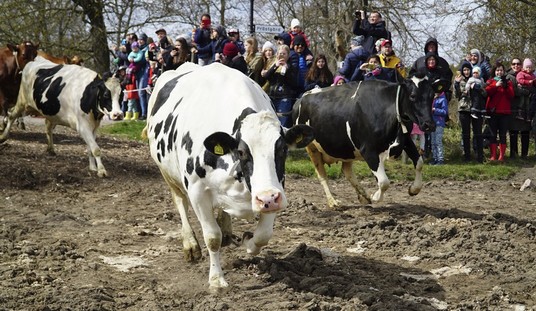If you’re reading that headline and thinking it sounds familiar, it’s because the news about the Livermore lab study was broken a month ago. James Rosen of Sinclair got wind of the fact that “Z Division,” Livermore’s intelligence outfit, produced a top-secret report last spring alleging that it was indeed possible that the virus leaked from a Chinese lab. John wrote about it at the time. Rosen’s article was thin on details, though, as he didn’t obtain the study. He was simply told about it by sources in the know.
Today’s Wall Street Journal story about the Livermore study is also short on specifics but supplies two important bits of information. One is that researchers apparently saw evidence of a lab origin in the genome of the virus itself:
A report on the origins of Covid-19 by a U.S. government national laboratory concluded that the hypothesis claiming the virus leaked from a Chinese lab in Wuhan is plausible and deserves further investigation, according to people familiar with the classified document…
People familiar with the study said that it was prepared by Lawrence Livermore’s “Z Division,” which is its intelligence arm. Lawrence Livermore has considerable expertise on biological issues. Its assessment drew on genomic analysis of the SARS-COV-2 virus, which causes Covid-19, they said.
Why is that important? Because the scientific consensus (even now) is that the genome points away from the lab-leak theory and towards an animal origin for SARS-CoV-2. I wrote about one such analysis yesterday. Another influential study published last March describing an examination of the genome also concluded that “analyses clearly show that SARS-CoV-2 is not a laboratory construct or a purposefully manipulated virus.” (One of the co-authors of that study, Kristian Andersen, emailed Anthony Fauci a few weeks before it was published to say that, from what he’d seen of the genome at that point, it did resemble something engineered. His change of heart hasn’t been fully explained as far as I’m aware.) Today’s Journal scoop reveals that that conclusion was being challenged early on in the pandemic, as of May 2020, by an outfit as eminent as Livermore. Which means the genomic evidence may be more ambiguous than we thought.
The other important detail is the timeline. “State Department officials received the study in late October 2020 and asked for more information, according to a timeline by the agency’s arms control and verification bureau,” says the Journal. That was five months after the Livermore study was finished. Why did it take so long to circulate? Did the Trump State Department just not develop an interest in the virus’s origins until later in 2020, as the election approached? Or were they stonewalled by a science bureaucracy that wanted to keep the Livermore study under wraps? “The Z Division report received only limited distribution at the time of its issuance, sources said, prompting some senior U.S. officials in the Trump administration to make inquiries into why it had not been brought to their attention last May,” Rosen reported last month. “Senior officials at the Energy and State Departments were said to have intervened to quash efforts by lower-level U.S. officials who, intrigued by the Z Division report, contacted the Livermore scientists who wrote it to seek additional information.”
Mike Pompeo was the most senior official at State, of course. Did he intervene to suppress the study? Or did his deputies do it, unbeknownst to him? Pompeo hasn’t been shy lately about reminding people that his agency was the one that finally lent credence to the lab-leak theory in a fact sheet published a few days before Biden’s inauguration.
Pompeo’s not the only Republican taking a modest victory lap over the mainstreaming of the lab-leak theory. Tom Cotton, one of the earliest proponents of the possibility, has a piece in NRO today compiling all of the circumstantial evidence that now points towards a lab accident. Exhibit A: The behavior of the Chinese government.
[T]he Chinese government has not behaved like an innocent victim. Instead, it has acted consistently as if it’s covering up a terrible secret in Wuhan. In December 2019, the WIV’s infamous bat expert, Dr. Shi Zhengli, deleted data and purged phrases such as “wild animal samples,” “cross-species infection,” and “emerging infectious diseases” from institute databases. The next month, the Chinese government installed its top military epidemiologist at the WIV, putting it under the control of the People’s Liberation Army. Last February, Chairman Xi Jinping announced that China would fast-track legislation to reform the nation’s biosecurity laws. Chapter Five of that law addresses “biosafety of pathogenic microorganism laboratories” — in other words, lab leaks. And the Chinese government purged hundreds of studies relating to bat-coronavirus research, including research by Dr. Shi.
Still, plenty of virologists seem to believe that the balance of evidence from the genome itself better supports zoonotic origin than something built in a lab. For the latest argument, scroll through this useful but jargon-heavy Twitter thread by a professor in the field, Stuart Neil. It helps to know going in that RaTG13 is the bat coronavirus that killed three Chinese miners back in 2012; it shares 96 percent of its genome with SARS-CoV-2, making it the closest known relative to the virus that causes COVID. My understanding, though, is that that’s actually not a terribly close resemblance. Humans and chimps share 99 percent of their DNA, after all. Neil’s first point in the thread is that scientists couldn’t “build” SARS-CoV-2 out of RaTG13, as they’re simply too dissimilar. They would have needed a closer viral relative as a foundation. But where is that virus?
His second point is that there’s also circumstantial evidence that points away from a lab leak:
Most likely vectors would be a member of the Zhi lab – but they’re all seronegative according to them. According to unsubstantiated intelligence, 3 WIV workers are reported ill. They visit the hospital – not uncommon I hear for Chinese to do this even with flu (and it was season)
— Stuart Neil (@stuartjdneil) June 7, 2021
Lastly, most initial cases known are associated with one of 3 wet markets, and the known epidemiology shows the infections moving from there west across the river – ie towards the WIV not away from it.
— Stuart Neil (@stuartjdneil) June 7, 2021
He ends by noting that, although it may be true that we haven’t found anything in nature that looks very similar to SARS-CoV-2, that’s really not surprising. We’ve only seen the tip of the iceberg when it comes to “sarbecoviruses,” of which coronaviruses are one subset. Some of those sarbecoviruses have some of the same distinct features as SARS-CoV-2, like the furin cleavage site, which some analyses have treated as smoking-gun proof of genetic manipulation. Sarbecoviruses show a lot of recombination too as they circulate, which makes it more likely that one mutation might have ended up as SARS-CoV-2 by chance. The bottom line: The jury’s still out on the genome. And if that ends up being the best evidence we have of the virus’s origins, it’ll be officially undetermined forever.








Join the conversation as a VIP Member